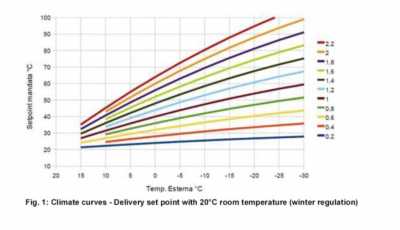I've been playing around with our heat curves this spring just to get a feel for what'll work best this coming winter.
We've found the house to be very comfortable at 0.8 and 1 (based on the graph below) in early spring when temperatures were dropping to around 3C at nighttime.
Two nights ago, I dropped the curve to 0.2 to see what would happen. The house remained the same temperature and was consuming the same amount of power as on 0.8-1 and the flow temperatures have remained exactly the same in the 32-35C range. Ambient temperatures have been roughly the same and yesterday it was the warmest day yet, so I assumed we'd see drop off, but we didn't.
Am I correct to think that the lower the curve, the lower the flow temperatures should ultimately be and therefore consume less power?
Also, on a related note, what is the lowest flow temperature a heat pump can deliver – our towels struggle to dry in the summer when the heating's off, so I was thinking of running the rad circuit only the lowest possible curve to just deliver some heat to the towel rails.
Thoughts?
Get a copy of The Ultimate Guide to Heat Pumps
Subscribe and follow our YouTube channel!
@editor @grahamh might be able to give an insight due to his vast experience
https://renewableheatinghub.co.uk/weather-compensation-and-heat-pumps-the-verdict
Did you purchase the book?
@dandee, yes, I've got the book... not really covered to be honest.
Get a copy of The Ultimate Guide to Heat Pumps
Subscribe and follow our YouTube channel!
If you are not seeing a change in LWT with outside temperature, then I would question whether your system is operating in WC mode, or that there is a problem with the controller algorithms.
Looking at the graph, not only is the expected change is LWT lower at higher outside temperatures, you may also have the case where it runs off the end of the curve, so the LWT may remain constant.
There may be a lower cut off for flow temp built in. From what I've seen with Ecodans it's hard to get them to run at very low flows; yours may be similar.
I'm not sure it's a good idea trying to run a large ASHP like yours at very low output. It's not going to be efficient and will probably reach the flow temp very quickly then turn off anyway. If I wanted to heat the towel rails I'd be tempted to run it at a higher fixed flow for a short time. Or just hang the towels out on the washing line. 😉
Posted by: @editorour towels struggle to dry in the summer when the heating's off, so I was thinking of running the rad circuit only the lowest possible curve to just deliver some heat to the towel rails.
just fit elec heating elements to your rails? thats what I have. cop of 1 but such a low usage doesn't matter?
My octopus signup link https://share.octopus.energy/ebony-deer-230
210m2 house, Samsung 16kw Gen6 ASHP Self installed: Single circulation loop , PWM modulating pump.
My public ASHP stats: https://heatpumpmonitor.org/system/view?id=45
11.9kWp of PV
41kWh of Battery storage (3x Powerwall 2)
2x BEVs
Posted by: @abernyteThis is a fascinating topic for any Heat Pump owner who is even slightly curious in getting the maximum efficiency from their device. Thank you to those knowledgeable posters who have provided the information.
I have a Mitsubishi Ecodan 14kW with a FTC5 and PAR-WR51R-E wireless controller heating radiators. Since installation the system is set to Auto Adaption mode and has worked flawlessly in heating my 180m2 1992 built timber framed house through periods of serious cold wet and windy weather in North East Scotland.
The installer said that Fixed Flow was only used for commissioning, Weather Comp Curve was too slow to react in our exposed location and that Auto Adaptive setting would give me the best of all worlds in that it auto-magically tweaked the curve on the fly to maintain a comfortable house. In terms of costs is has been more successful than I had ever hoped in reducing the energy bills by around 60% from LPG, electrical heaters and solid fuel used previously. According to the FTC5 my flow temps seem not to vary greatly from between 33C and 36C, even in the depths of winter. My 2022 stats show I consumed 6400kWhs for whole house heating and hot water use which I do not consider bad (perhaps naively) with an overall COP of 4.2
My reading here suggests that weather compensation is the way to go but is there really going to be much difference and savings over my current setup?
Thank you for sharing this.
It is my understanding that Auto Adaptive works based on the weather compensation curve, so I would be interested in knowing how your installer set up yours.
I have a Mitsubishi Ecodan 8.5kW with a FTC6 and Mitsubishi wireless thermostat. The installer set the weather compensation curve at 45@-3 and 35@15 and selected Auto Adaptive mode, using the Mitsubishi default -5C, +5C range. I adjusted the compensation curve so that it is 25@15 instead of 35@15 as I found this setting sufficient and also the unit cycled less (one or o times per hour). HW runs for a maximum of 90 minutes (ECO mode) up to 50C. The indoor temperature is programmed to vary from 18C (night time) to 20C during the day.
The house is warm (98m2, loft and cavity wall insulated, all radiators upgraded to 2 panels & double convector and living room to 3 panels rad) and I have calculated that for instance yesterday I spent £4.68 inc VAT for a total consumption of 19.27kWh (smart meter to energy supplier to me via API).
Said this, I see on MelCloud that Heating estimated consumed energy is ~16.5kWh and estimated delivered energy is ~51kWh, resulting in a COP of ~3.09.
One month ago, I tried to use the Weather Compensation Mode, but found that my heat pump increased the flow temperature somehow too fast and therefore turned off. This caused frequent cycling (5-6 per hour, roughly every 10 minutes, which is also the timing when the temperature is monitored / checked in the setting - increasing this parameter to, lets say 1h, did not really reduce the cycling though). For this reason and the fact that the house did not get really warm, I switched it back to Auto Adaptive.
Any thought on why I never get a COP higher than 3.0-3.1?
Also, does the weather compensation curve refer to the flow temperature entering in the system or the return flow temperature?
Thank you in advance.
Posted by: @pdp10Posted by: @abernyteThis is a fascinating topic for any Heat Pump owner who is even slightly curious in getting the maximum efficiency from their device. Thank you to those knowledgeable posters who have provided the information.
I have a Mitsubishi Ecodan 14kW with a FTC5 and PAR-WR51R-E wireless controller heating radiators. Since installation the system is set to Auto Adaption mode and has worked flawlessly in heating my 180m2 1992 built timber framed house through periods of serious cold wet and windy weather in North East Scotland.
The installer said that Fixed Flow was only used for commissioning, Weather Comp Curve was too slow to react in our exposed location and that Auto Adaptive setting would give me the best of all worlds in that it auto-magically tweaked the curve on the fly to maintain a comfortable house. In terms of costs is has been more successful than I had ever hoped in reducing the energy bills by around 60% from LPG, electrical heaters and solid fuel used previously. According to the FTC5 my flow temps seem not to vary greatly from between 33C and 36C, even in the depths of winter. My 2022 stats show I consumed 6400kWhs for whole house heating and hot water use which I do not consider bad (perhaps naively) with an overall COP of 4.2
My reading here suggests that weather compensation is the way to go but is there really going to be much difference and savings over my current setup?
Thank you for sharing this.
It is my understanding that Auto Adaptive works based on the weather compensation curve, so I would be interested in knowing how your installer set up yours.
I have a Mitsubishi Ecodan 8.5kW with a FTC6 and Mitsubishi wireless thermostat. The installer set the weather compensation curve at 45@-3 and 35@15 and selected Auto Adaptive mode, using the Mitsubishi default -5C, +5C range. I adjusted the compensation curve so that it is 25@15 instead of 35@15 as I found this setting sufficient and also the unit cycled less (one or o times per hour). HW runs for a maximum of 90 minutes (ECO mode) up to 50C. The indoor temperature is programmed to vary from 18C (night time) to 20C during the day.
The house is warm (98m2, loft and cavity wall insulated, all radiators upgraded to 2 panels & double convector and living room to 3 panels rad) and I have calculated that for instance yesterday I spent £4.68 inc VAT for a total consumption of 19.27kWh (smart meter to energy supplier to me via API).
Said this, I see on MelCloud that Heating estimated consumed energy is ~16.5kWh and estimated delivered energy is ~51kWh, resulting in a COP of ~3.09.
One month ago, I tried to use the Weather Compensation Mode, but found that my heat pump increased the flow temperature somehow too fast and therefore turned off. This caused frequent cycling (5-6 per hour, roughly every 10 minutes, which is also the timing when the temperature is monitored / checked in the setting - increasing this parameter to, lets say 1h, did not really reduce the cycling though). For this reason and the fact that the house did not get really warm, I switched it back to Auto Adaptive.
Any thought on why I never get a COP higher than 3.0-3.1?
Also, does the weather compensation curve refer to the flow temperature entering in the system or the return flow temperature?
Thank you in advance.
It's often said that the Ecodan internal consumption measurements over estimate. If so your COP might be better than you see.
But - Auto adapt bumps up the flow temp a lot when it's warming up the house. Unless you limit it, it could get up to 50 (45 + 5) after your set back. Can you check on Melcloud? This will make the COP lower but of course will use less/no energy at night. I have similar temps to you and my COP is about 3.6 just now. I limit the flow temp to 43 deg though.
WC curve is LWT, i.e. what the ASHP sends out.
I am afraid that I have never peered too deeply into the settings to find exactly how the curve is configured. The installer spent some time on this part of the commissioning and acknowledging that the house is a leaky and exposed timber frame he wanted to match the "normal" heat loss with the input as low as possible and I do not seem to get much cycling at all with long uninterrupted runs unless defrost is called for. It was further tweaked by a couple of local (Perth) Mitsubishi service agents when it got it's first service from them at year three. They squeezed out every last drop of efficiency and got the normal flow temps down even further so it rarely goes over 35C. Big radiators and a big heatpump and a heavy dose of glycol to boot. They only do heat pump servicing and repairs with Mitsubishi and Daikin, no installation work, and are worth every penny!
- 26 Forums
- 2,342 Topics
- 53 K Posts
- 229 Online
- 6,000 Members
Join Us!
Worth Watching
Latest Posts
-

RE: External pipework insulation
Have a look at this previous post where I talked about ...
By Transparent , 2 hours ago
-
RE: Controlling Daikin Altherma via P1P2 and Home Assistant
@majordennisbloodnok That’s correct. I can’t find anywh...
By weoleyric , 3 hours ago
-
RE: Octopus Cosy Heat Pump Owners & Discussion Thread
@andrewj yeah we recreated it. Engineer seemed to think...
By swwils , 4 hours ago
-

RE: Free Ecoheat Heat Pump Install
This is an interesting way of looking at it, and I can ...
By Mars , 7 hours ago
-

RE: Configuring third party dongle for Ecodan local control
That's a good spot and a valuable insight, @sheriff-fat...
By Majordennisbloodnok , 7 hours ago
-

RE: Are We Sleepwalking Into Another Race to the Bottom?
@majordennisbloodnok And did ‘Honey’ order it for you? ...
By Toodles , 7 hours ago
-

RE: Setback savings - fact or fiction?
@robs — thanks again for your detailed comments. Some r...
By cathodeRay , 21 hours ago
-

RE: A Smarter Smart Controller from Homely?
@papahuhu I hope you get a swift resolution. Regards, T...
By Toodles , 1 day ago
-

RE: Poll for Time of Use, tariffs, technology
That’s fine by me too Major, I feel it is a sad reflect...
By Toodles , 1 day ago
-

Bingo. Sometimes a judiciously placed size 10 bovver bo...
By Majordennisbloodnok , 1 day ago
-
RE: Mitsubishi Ecodan 11.2kW heat pump with low COP
@ciocoiu-alexandru I can't provide the same level of di...
By Sheriff Fatman , 1 day ago
-

The three technical issues I'm considering are: BMS...
By Transparent , 1 day ago
-
RE: LiFePO4 lithium battery fires and explosions
@transparent Your post may fit better in th...
By Batpred , 1 day ago
-

RE: British Gas vs Octopus Energy vs Heat Geek vs EDF vs Aira vs OVO vs EON.Next vs Boxt
@jamespawhite, if you could be bothered, you could also...
By Mars , 1 day ago
-
RE: Commencing on an ASHP Installation Process
I've got a bit of time to draft something today, so the...
By Sheriff Fatman , 2 days ago
-
RE: Help with heat pump sizing
@amin I dont think materially relative to t...
By JamesPa , 2 days ago
-

@majordennisbloodnok I have decided to take the plunge....
By TechnoGeek , 2 days ago
-
RE: Different dT on each radiator?
I cant sorry. Its based on some calculations I did fro...
By JamesPa , 3 days ago







